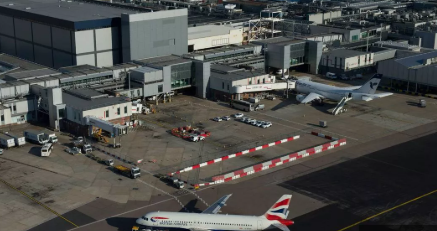
Flights have begun landing at London’s Heathrow Airport after a massive fire at a power station caused widespread travel chaos, grounding flights at Europe’s busiest air hub for most of the day.
The fire, which broke out at an electricity substation, led to the cancellation or diversion of hundreds of flights, affecting thousands of travelers worldwide. The disruption raised concerns about the vulnerability of critical airport infrastructure.
An AFP journalist observed planes landing at Heathrow late on Friday, while British Airways confirmed that it had received clearance to operate eight long-haul flights, including routes to Johannesburg, Singapore, and Riyadh.
The fire, which started late Thursday night, caused a major power outage, temporarily cutting off electricity to 100,000 homes. National Grid, the UK’s electricity provider, managed to partially restore power to Heathrow and nearby affected areas by 2:00 PM GMT on Friday.
Heathrow’s chief executive, Thomas Woldbye, confirmed that normal operations were expected to resume by Saturday, calling the incident “of major severity” after a backup transformer also failed.
“We lost power equivalent to that of a mid-sized city,” Woldbye explained.
The London Fire Brigade described the fire as “non-suspicious”, stating that the investigation would focus on electrical distribution equipment. However, London’s Metropolitan Police Counter Terrorism Command is also involved in the probe, given the incident’s impact.
“While there is currently no indication of foul play, we are keeping an open mind,” a police spokesperson said.
More than 1,350 flights were scheduled to depart or arrive at Heathrow on Friday, with around 230,000 passengers affected. Some flights were rerouted to Gatwick Airport, while others were diverted to European airports, including Shannon (Ireland), Frankfurt (Germany), and Paris Charles de Gaulle (France).
Aviation analysts estimate the financial impact of the shutdown to exceed £50 million ($64.7 million) in losses for airlines and the airport.
The incident has sparked debate about Heathrow’s infrastructure resilience, with Energy Secretary Ed Miliband acknowledging that the scale of the disruption was unprecedented.
“But it makes Heathrow look quite vulnerable. We need to ensure that major national infrastructure is better protected,” he told ITV News.
Meanwhile, Willie Walsh, director-general of the International Air Transport Association (IATA), criticized Heathrow’s reliance on a single power source, questioning why alternative backup systems were not in place.
With flights gradually resuming, airport officials say they are working to clear backlogs and minimize further disruptions. However, the full extent of the damage and long-term implications for Heathrow’s operations remain unclear.







